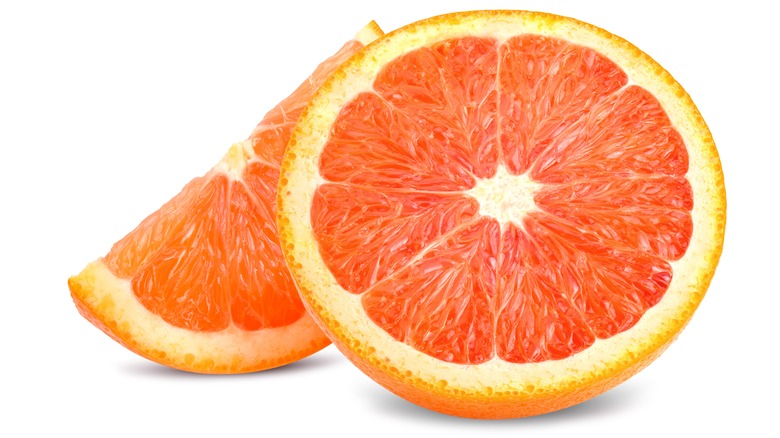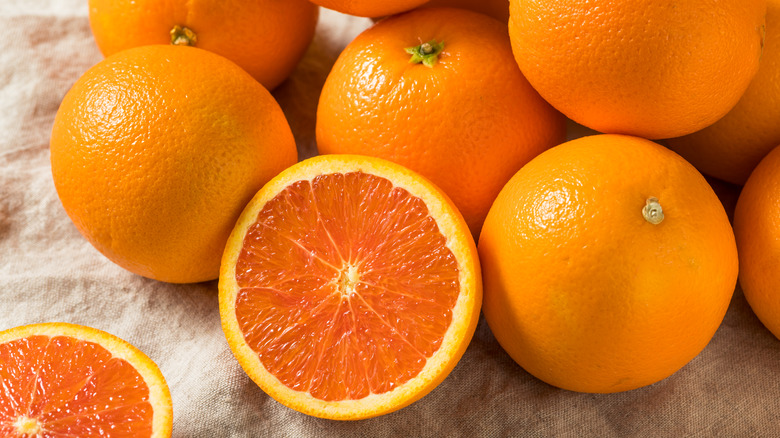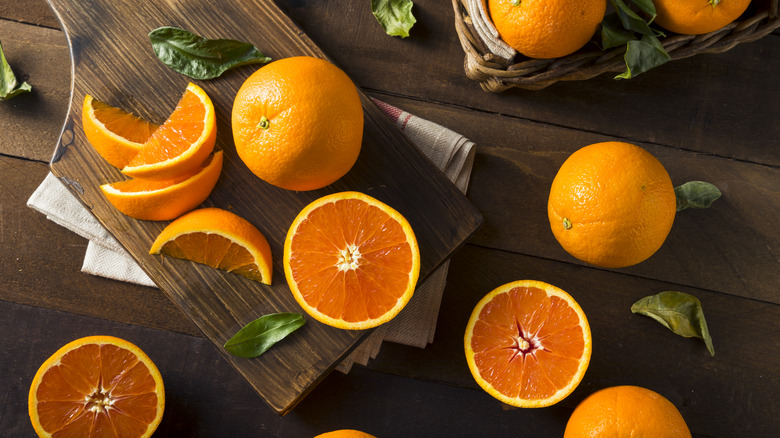Cara Cara Oranges: The Colorful Variety That Packs A Sweet Punch
Whether sipping on a glass of OJ in the morning, baking a lemon tart for dinner, or spritzing lime on a taco; it's fair to say citrus integrates into a diverse range of applications. With hundreds of varieties exhibiting different flavors, shapes, and colors, it's hard to believe that the entire range of fruit emerged from only three original citrus types — citron, pomelo, and mandarin orange, according to Leafy Place. In fact, the progenitor of sweet citrus came around 3,300 years ago in modern-day China; previously, these round fruits were too tart for consumption. Yet since the plant easily breeds between species, humans hybridized a fruitful abundance of oranges, explains BBVA Open Mind. And many of these newly bred innovations are recent — there are plenty of modern innovations of citrus types, per Growing Produce.
The Cara Cara orange, discovered in 1976, is exactly such a youthful fruit gaining popularity, per Food Network. Let's dive into what makes these oranges so unique.
What are Cara Cara oranges?
Cara Cara oranges are a hybrid between two navel orange breeds — the Washington Navel and the Brazilian Bahia. Only emerging in 1976, this vibrant citrus now dominates the American market, being one of the most-sold fresh fruits in the nation. It's easy to see why — not only are they higher in Vitamin C than other oranges, their flavor is bright, sweet, and not overly acidic. With notes of berries, rose, and just a hint of tartness, the balanced fruit is easy to cook with or to enjoy on its own, notes MasterClass.
A cousin to grapefruit, the inside of the Cara Cara is bright pink, making it easy to distinguish from other citruses. Like other navel oranges, they're seedless, meaning they're hassle-free to juice and enjoy as a snack. Cara Cara's growing season is from November to April — making the citrus a great dash of sweet flavor in the winter months, per The Kitchn. They're also easy to integrate into the kitchen — let's dive into how to cook with them.
How to cook with Cara Cara oranges
Cara Cara oranges are highly versatile. Unlike other oranges, their juice does not turn bitter after exposure to oxygen, instead retaining a palatable sweetness. As a result, they work well in raw applications, as an addition to salads, salsas, and other vegetable applications. Their berry flavor is also highlighted after heat, so don't shy away from using them in baked goods, too, and as an enhancer with meat and poultry, notes The Spruce Eats.
Harry and David offers an example of a delectable dish made with the orange — roasting a chicken atop Cara Cara slices and covering the bird with an orange honey glaze. Alternatively, integrate the essence of the orange even more seamlessly by simmering the peels in olive oil for 10 minutes, creating an olive oil infusion (via Food 52). MasterClass recommends starting your day with Cara Cara in a smoothie or celebrating a happy hour with a mimosa made from citrus. The options are endless — with their pleasant flavor, there's a myriad of ways to enjoy.
Nutritional benefits of Cara Cara oranges
In addition to their pleasant flavor, Cara Cara oranges exhibit a range of nutritional benefits. One medium specimen contains approximately 80 calories and a hefty amount of vitamins and minerals. When it comes to snacking potential, the oranges don't contain much protein; however, they do offer a substantive amount of carbs and fiber — making them nutritionally dense for their relatively low-calorie content. Like other citruses, Cara Caras provide 150% of the daily intake norm of vitamin C, which aids with skin and joints. They can also improve eyesight, containing 30% of the daily intake of Vitamin A., per Live Strong.
In addition to their vitamin content, Cara Cara's most important contained antioxidant is lycopene. Responsible for their color, this powerful antioxidant prevents heart disease and prostate cancer, and slows vision degeneration, notes The Food Network. Lycopene is also readily found in watermelon (per the United States Department of Agriculture)– so consider mixing the two juices for an ultra-satiated antioxidant punch.



